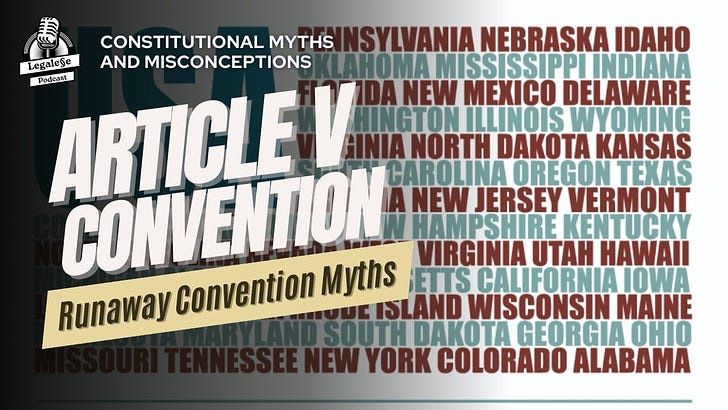Show Notes - Article V Myths & Misconceptions
Description
Episode #86
Today On Legalese we have the latest video in my series: Constitutional Myths & Misconceptions. This will be a deep dive into founding era law and history to conclusively debunk the Runaway Convention Fallacy.
The Constitution’s framers and ratifiers understood that dysfunction can afflict any government system, no matter how well crafted. So the Constitution gives citizens the direct means to rein in federal power and cure federal dysfunction through a “Convention for proposing Amendments.”
We will dig deep into this provision and describe how it works. As well as correcting some common misunderstandings of the process that exist.
The Congress, whenever two thirds of both Houses shall deem it necessary, shall propose Amendments to this Constitution, or, on the Application of the Legislatures of two thirds of the several States, shall call a Convention for proposing Amendments, which, in either Case, shall be valid to all Intents and Purposes, as Part of this Constitution, when ratified by the Legislatures of three fourths of the several States, or by Convention in three fourths thereof, as the one or the other Mode of Ratification may be proposed by the Congress.
~Article V
The founding generation used the Article V process to adopt 12 separate amendments—the Bill of Rights and the 11th and 12th amendments. Since the Founders’ time, Americans have continued to address some problems with amendments. But for many years there have been no proposed amendments to deal with federal dysfunction because Congress refuses to propose anything to curb their own excesses.
That is why there has been a recent surge in interest in Article V’s mechanism for bypassing Congress. The Founders added the convention method of proposal as a crucial check-and-balance: It empowers the people, through their state legislatures, to correct federal dysfunctions that Congress might refuse to address.
Facts and Myths
Article V is relatively short because there was no need to repeat information that everyone knew. It does not explain the rules of the convention, because those rules were universally understood: There had been many “conventions of the states,” and all had followed much the same procedures.
Unfortunately, as most people simply don’t understand where to look to clarify the substance and process of amending the Constitution through a Convention of the States, this has allowed myths and misconceptions to form, often intentionally. Among the most common false narratives were that the gathering would be a “constitutional convention,” that it couldn’t be controlled, and (inconsistently) that it would be controlled by Congress. However, none of these claims have any legal or historical merit.
While opponents of Article V claim a convention of the states would be so treacherous that it is simply to dangerous to attempt— there is a recent groundswell of people learning about the true nature of such a convention who have come to believe the exact opposite is true. What would really be too treacherous would be for us to allow this constitutional check on federal power become a dead letter.
As George Mason of Virginia said at the constitutional convention:
Amendments therefore will be necessary. . . It would be improper to require the consent of the Natl. Legislature, because they may abuse their power, and refuse their consent on that very account.1
Links
Simulation Shows What An Amendments Convention Would Be Like
Article V Process for State Legislatures to Amend the U.S. Constitution
Amending the Constitution by Convention: Practical Guidance for Citizens and policymakers (Independence Institute, 2012)
Documentary History of the Ratification of the Constitution (University Of Virginia)
Wisconsin Historical Society's Documentary History of the Ratification of the Constitution
Virginia Calls a Second Constitutional Convention 30 October–20 November 1788
Amending The Constitution By Convention Series
Amending the Constitution by Convention: Rules Governing the Process, 78 Tenn. L. Rev. 693 (2011)
Amending the Constitution by Convention: Practical Guidance for Citizens and Policymakers (Independence Institute, 2012)
Amending The Constitution by Convention: Lessons for Today from the Constitution’s First Century (Independence Institute, 2011)
Amending the Constitution by Convention: A More Complete View of the Founders’ Plan (Independence Institute, 2010)
Law Review Articles
Natelson, Robert G., Founding-Era Conventions and the Meaning of the Constitution’s 'Convention for Proposing Amendments' (April 22, 2012). Florida Law Review, Vol. 65, 2013.
Natelson, Robert G., Proposing Constitutional Amendments by Convention: Rules Governing the Process (August 3, 2011). Tennessee Law Review, Vol. 78, p. 693, 2011.
Natelson, Robert G., Is the Constitution’s Convention for Proposing Amendments a 'Mystery'? Overlooked Evidence in the Narrative of Uncertainty (June 3, 2020). Marquette Law Review, Vol. 104, 2020.
Natelson, Robert G., The State-Application-and-Convention Method of Amending the Constitution: The Founding-Era Vision (2011). Thomas M. Cooley Law Review, Vol. 29, No. 1, p. 9, 2011.
Natelson, Robert G., Why the Constitution's 'Convention for Proposing Amendments' Is a Convention of the States (June 3, 2020). Marquette Law Review, Vol. 104, No. 1, 2020.
The Article V Convention Process and the Restoration of Federalism, 36 Harvard J. L. & Pub. Pol. 955 (2013).
Past Episodes
Follow and Support
Subscribe to the Legale§e Newsletter You will get notifications for all new content, whether it’s articles, podcasts or videos!
Visit the Legale§e Podcast homepage to learn more about the show, get updates, contact me, buy my book, find links to my social media & more!
Follow
Support
BUY MY NEW BOOK
Constitutional Sleight Of Hand: An explicit history of implied powers Now Available on Amazon
1 FARRAND’S RECORDS at 202-03 (Jun. 11, 1787). See also 2 id. at 629 (Sept. 15, 1787).



